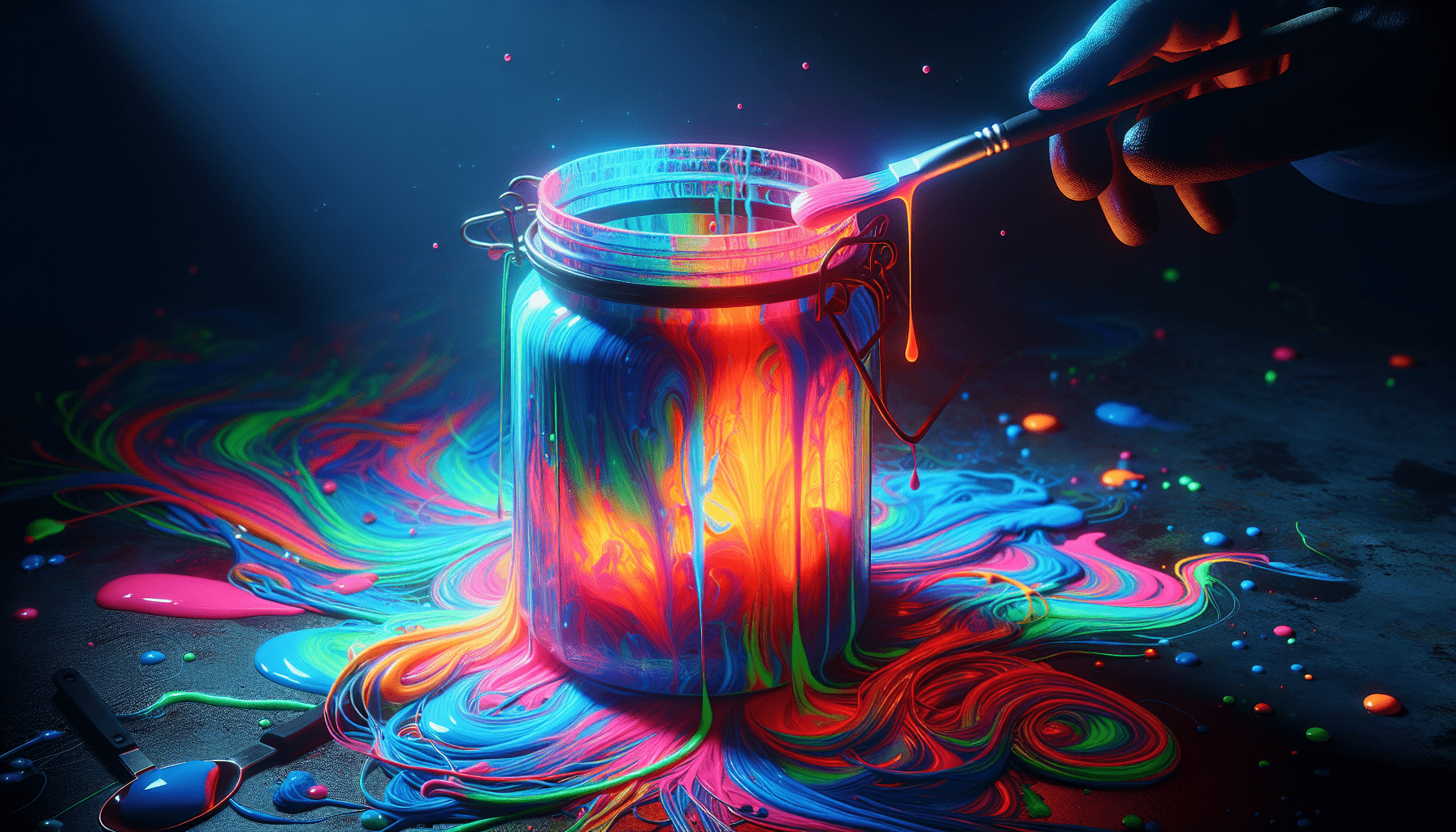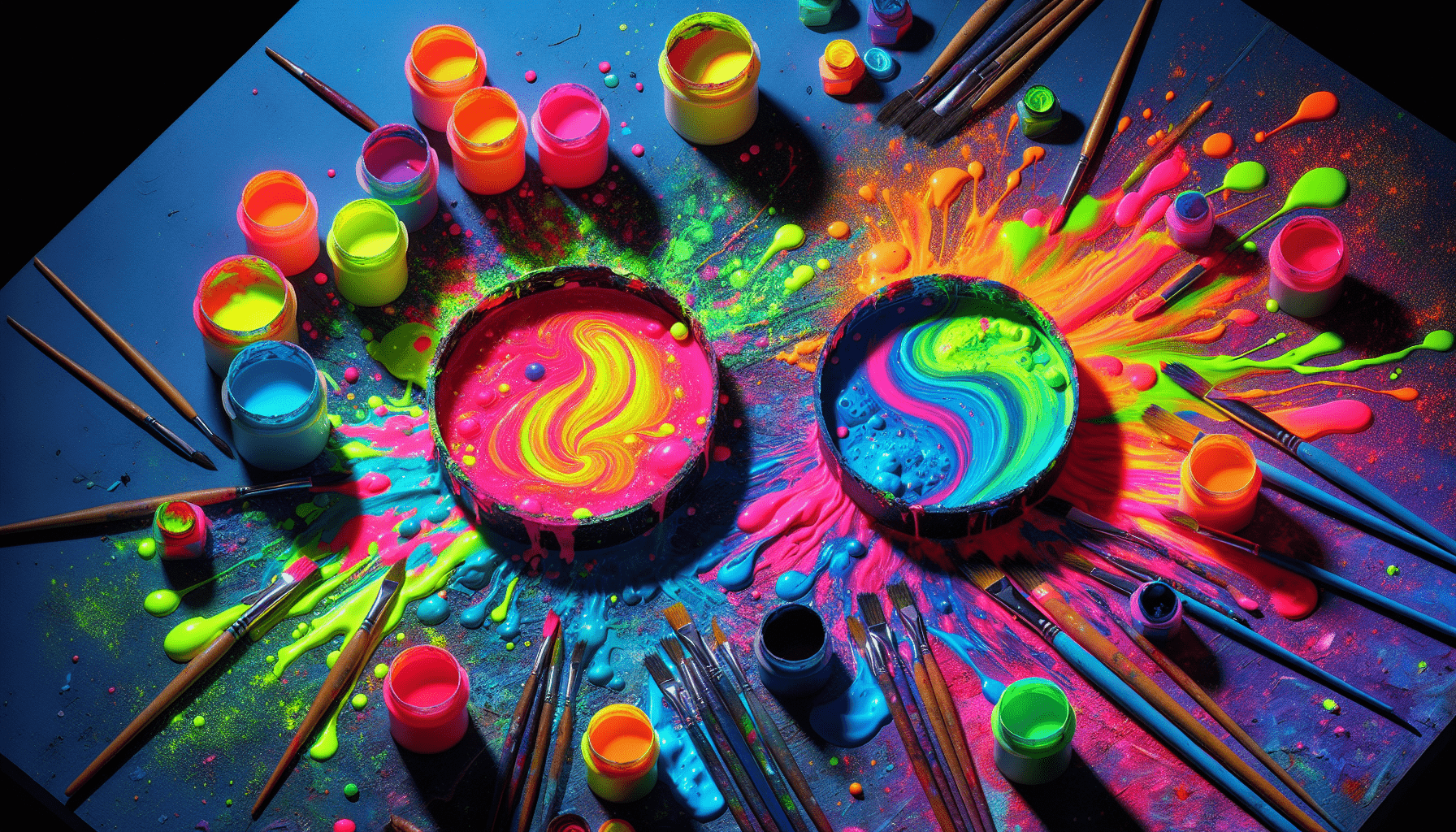In the world of paint, experimentation often leads to remarkable discoveries. One question that frequently arises is whether it is possible to mix fluorescent paint with normal paint. This article will explore the compatibility of these two types of paint, examining the potential benefits and considerations that come into play when attempting to create a fusion of vibrant fluorescence and classic pigments. Whether you’re an artist seeking to push the boundaries of your artistic expression or a homeowner looking to add a dash of luminosity to your walls, understanding the compatibility of fluorescent paint and normal paint is essential.

Introduction
Paint is a versatile medium that allows artists, designers, and homeowners to add color and personality to their projects. One type of paint that has gained popularity in recent years is fluorescent paint. With its vibrant colors and high visibility under UV light, it offers a unique and eye-catching effect. However, many people wonder if it is possible to mix fluorescent paint with normal paint. In this article, we will explore the characteristics of fluorescent and normal paint, their chemical compositions, compatibility, and the effects of mixing them. We will also provide precautions, recommendations, and creative applications for using a mixture of fluorescent and normal paints.
Understanding Fluorescent Paint
Definition and Characteristics
Fluorescent paint is a type of paint that contains phosphors, which are chemical compounds that emit visible light when exposed to radiation. This radiation is typically in the form of ultraviolet (UV) light. The glow produced by fluorescent paint is incredibly bright and intense, giving objects painted with it a striking appearance. Fluorescent paints are available in a wide range of colors and can add a vibrant and energetic touch to any project.
Common Uses
Due to their high visibility under UV light, fluorescent paints are commonly used in a variety of applications. They are popular in the entertainment industry for creating special effects in concerts, clubs, and theaters. Advertisers and marketers also utilize fluorescent paints to make their products or messages stand out. Additionally, fluorescent paints are widely used in safety applications such as signage, highway markings, and personal protective equipment to enhance visibility in low-light environments.
Advantages and Disadvantages
One of the main advantages of fluorescent paint is its ability to grab attention and create a visual impact. It can instantly transform a dull surface into a vibrant and attention-grabbing one. Fluorescent paints are also known for their longevity and resistance to fading, which makes them suitable for both indoor and outdoor applications. However, there are also a few disadvantages to consider. Fluorescent paints are often more expensive than regular paints, and their intense colors may not be suitable for all design schemes. Additionally, they may require additional precautions during application due to their higher toxicity levels.
Understanding Normal Paint
Definition and Characteristics
Normal paint, also known as conventional paint, refers to the standard type of paint commonly used for various painting projects. It is typically made up of pigments, binders, solvents, and additives. Normal paints come in a wide range of colors, finishes, and sheens to suit different preferences and applications. Unlike fluorescent paints, normal paints do not possess the unique luminescent properties that make fluorescent paints stand out.
Common Types of Normal Paint
There are several common types of normal paint, each with its own characteristics and applications. Latex paint is water-based and dries quickly, making it a popular choice for interior walls. Oil-based paint, on the other hand, offers a more durable and moisture-resistant finish, making it suitable for surfaces exposed to high levels of wear and tear, such as furniture or trim. Other types of normal paint include enamel paint, acrylic paint, and spray paint, each with its own unique properties.
Chemical Composition of Fluorescent Paint
Fluorescent paint contains specific chemical compounds called phosphors, which are responsible for the fluorescent or luminescent effect. These phosphors are often mixed with a binder, such as acrylic or latex, to form a paintable consistency. In addition to the phosphors, fluorescent paints also contain pigments and additives to achieve the desired color and performance characteristics.

Chemical Composition of Normal Paint
Normal paint typically consists of pigments, binders, solvents, and additives. Pigments provide color and opacity to the paint, while binders act as the glue that holds the pigment particles together and adheres them to the painted surface. Solvents are used to thin the paint and make it easier to apply, while additives contribute to properties such as drying time, durability, and flow.
Compatibility of Fluorescent Paint and Normal Paint
Before attempting to mix fluorescent paint with normal paint, it is important to consider their compatibility. Due to their different chemical compositions, fluorescent and normal paints may not always blend well together. It is advisable to consult the manufacturers’ instructions and conduct a small test before committing to a larger project. Mixing incompatible paints may result in poor adhesion, color separation, or an altered fluorescent effect.
Effects of Mixing Fluorescent Paint with Normal Paint
Color and Light Properties
When fluorescent paint is mixed with normal paint, it can significantly alter the color and light properties of the mixture. The intensity of the fluorescent effect may be diluted, depending on the proportion and type of normal paint used. This can result in a less vibrant appearance under UV light. Additionally, mixing certain colors of normal paint with fluorescent paint can create entirely new shades and hues, offering a wider range of creative possibilities.
Consistency and Textures
The addition of normal paint to fluorescent paint can also affect the consistency and texture of the mixture. Normal paint may have a different viscosity or drying time compared to fluorescent paint, which can impact the final texture and finish. It is important to carefully mix and test the consistency of the paint before applying it to ensure a uniform and desired result.
Drying Time and Durability
The drying time and durability of the mixed paint can also be influenced by combining fluorescent and normal paints. Different types of normal paint have varying drying times, and adding them to fluorescent paint can prolong or accelerate the drying process. It is crucial to consider the compatibility of drying times to ensure proper adhesion and durability of the paint on the surface.
Precautions and Recommendations
Testing Compatibility
As mentioned earlier, it is essential to test the compatibility of fluorescent paint and normal paint before starting a project. This can be done by mixing small quantities of the paints and applying them to a test surface. Observing how the paints interact, dry, and perform under UV light will provide insights into their compatibility and any potential issues that may arise.
Ratio and Proportions
When mixing fluorescent paint with normal paint, it is crucial to maintain the proper ratio and proportions. Adding too much normal paint can dilute the fluorescent effect, while adding too little may lead to poor blendability and color separation. Following the manufacturer’s instructions and experimenting with different ratios can help achieve the desired balance.
Surface Preparation
Prior to applying a mixture of fluorescent and normal paint, thorough surface preparation is essential. Ensure that the surface is clean, dry, and free of any loose particles. Priming the surface with an appropriate primer can also improve adhesion and the overall finish of the paint.
Sealing and Protection
To protect and enhance the longevity of a paint mixture, applying a clear topcoat or sealer is highly recommended. This will provide an additional layer of protection against UV exposure, moisture, and general wear and tear. Selecting a topcoat that is compatible with both fluorescent and normal paints will ensure a seamless and lasting finish.
Creative Applications of Fluorescent and Normal Paint Mix
Art and Crafts
The ability to mix fluorescent paint with normal paint opens up a myriad of creative opportunities in the world of art and crafts. Artists can experiment with different color combinations and techniques to create unique and visually captivating pieces. From paintings to sculptures, the inclusion of fluorescent paint can add an extra dimension and vibrancy to artworks.
Interior and Exterior Design
In interior and exterior design, the combination of fluorescent and normal paint can create stunning visual effects. From accent walls to furniture, the incorporation of fluorescent paint can inject a bold and energetic atmosphere into any space. The UV-reactiveness of fluorescent paint can be particularly striking in nightclubs, theaters, or themed rooms, where it can enhance the ambiance and create an immersive experience.
Special Effects
Fluorescent and normal paint mixtures are also widely used in the production of special effects for film, television, and theater. The ability to manipulate color and light properties allows artists and technicians to create mesmerizing scenes and illusions. From glowing props and costumes to intricate stage designs, the combination of fluorescent and normal paint can transform ordinary objects into extraordinary visual spectacles.
Conclusion
While it is possible to mix fluorescent paint with normal paint, careful consideration and testing are essential to achieve desired results. Understanding the characteristics, chemical composition, and compatibility of these paints is crucial for a successful mixture. The effects of mixing fluorescent and normal paint can alter color, light properties, consistency, and drying time. By following precautions, recommendations, and exploring various creative applications, one can unlock the potential of a fluorescent and normal paint mix to add vibrancy, visual impact, and uniqueness to artistic, design, or entertainment projects.



